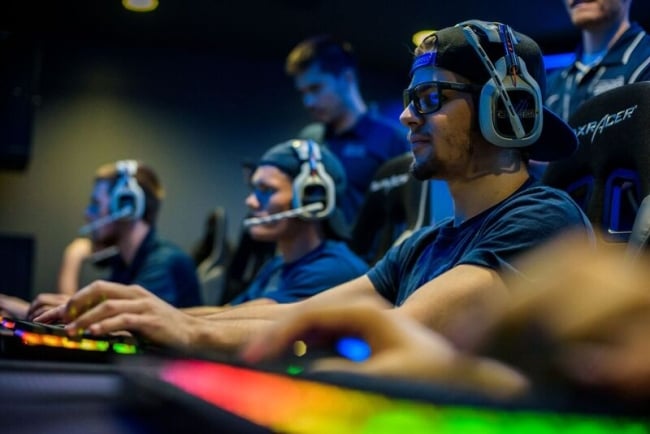You have /5 articles left.
Sign up for a free account or log in.

Esports athletes at Columbia College
NACE
Pacing the stage recently at the National Collegiate Athletic Association’s annual convention, President Mark Emmert ended his address to thousands of delegates with a surprising topic du jour: video games.
Emmert asked rhetorically -- as many athletics pundits have -- should the NCAA should control collegiate esports? It was apparently a phenomenon dominating conference discussions, as esports have blossomed from brand-new to burgeoning on campuses in fewer than five years, when the first college program was created.
Lingering criticism that esports, often viewed as a sedentary activity, can’t be regarded as an athletic endeavor hasn’t halted its proliferation into athletics departments and student affairs offices in an astonishingly short period.
Esports (not just within colleges) are expected to be valued at $1.4 billion by next year. At least two colleges are planning degrees in esports. The National Association of Collegiate Esports (NACE), the group that has seemingly emerged as the premiere governing body for “varsity”-level esports, has swelled to 128 members. It began in 2016 with six colleges and universities. The current slew of member colleges gave out just under $15 million in scholarships this academic year for students to strap on a headset, grab a mouse and keyboard, and enter the digital fray.
The esports allure for university executives is multifold but summed up succinctly for many institutions: enrollment boosts (although larger colleges and universities that are certainly not wanting for students also sponsor programs).
Granting scholarships to play video games, once perhaps just a Red Bull-fueled fantasy, attracts students -- especially men, who are in the minority in many undergraduate student bodies. And so officials have invested in pricey “arenas” for esports, spaces decked out with gigantic flat screens, slick computers and the best gaming accessories. One small private institution, New England College, with an enrollment of around 1,800 undergraduate students, and a prospective esports team of between 20 and 40 students, poured about $60,000 into its arena.
But esports’ newness on the college scene comes with a sense of unpredictability.
As one esports practitioner phrased it: “It’s a Wild West right now.”
How They Developed
The first known program to coax these games from the fringes of dormitory life and into the “varsity” mainstream was in 2014 with Robert Morris University-Illinois, an effort led at the time by Kurt Melcher, then the university’s associate athletics director. He unknowingly created the setup that many esports teams emulate today. Melcher still works part-time at Robert Morris but has since become the executive director of esports at Intersport, a sports consulting firm that the NCAA hired to research esports.
Robert Morris treated esports then just as it did traditional athletics, with a tough and often time-consuming practice schedule, uniforms and postgame meals -- all the hallmarks of a typical team. Universities with esports programs often hire coaches and other staffers, build their arenas, and develop aggressive recruitment strategies. Though universities’ picks of games vary, there are a couple cornerstones: Overwatch, a first-person shooter, and League of Legends, an arena-style game where you work with a team to try to destroy the opposition’s “base.”
The university offered scholarships for League of Legends, too, perhaps the biggest eyebrow-raiser among esports skeptics. But Melcher said in an interview he was adamant it should be elevated to the athletics department -- it was the difference in playing intramural basketball and an official university basketball team, giving esports more validity, he said.
In the summer of 2016 came NACE, promising “structure and legitimacy” for the esports universe, then just for its handful of members. NACE leaders designed a relatively minimalist constitution with basic academic standards and guidelines that students in the NACE membership needed to complete a degree within a five-year period.
Since that time, NACE has added more than 120 members. In interviews, esports enthusiasts attributed the growth to greater acceptance among administrators who grasped both the economic and entertainment benefits. Their popularity has spread outside higher education, too, with National Basketball Association franchises such as the Milwaukee Bucks fielding an esports team. About two years ago, the New York Yankees, the most lucrative team in professional baseball, invested in Vision Esports, the largest shareholder of three esports-related companies.
“This is dispelling the narrative of what a gamer is,” Melcher said.
An Unstructured Culture
Esports don’t have one accepted home on campuses.
Some institutions have established them in their student activities wing, similar to club sports, as 47 percent of the NACE members do, or through their athletics departments (40 percent of NACE universities). The remainder put their programs elsewhere, such as in academic departments.
While institutions can still compete with one another regardless of how their esports are structured, placing them within athletic departments has spurred concerns about the federal law that protects against gender discrimination, Title IX of the Education Amendments of 1972. About 90 percent of students on NACE teams are men.
Title IX does apply to student clubs, too, but athletic teams have particular requirements related to designating some teams as being for men and others for women. One way to be Title IX compliant is for an institution to match its proportion of male and female athletes to the ratio of its overall undergraduate enrollment -- and an esports team in an athletics department would be included in this calculation. Universities can also show a history of continuing program expansion, or that they have fully met the interests and abilities of both genders to meet Title IX.
Because of these complications, esports should be clearly defined as either sports or entertainment, said Ellen Staurowsky, a professor of sports management at Drexel University and a Title IX expert.
The law could also be triggered by some of the games’ content, Staurowsky theorized. As Emmert mentioned in his speech, video games carry a reputation of being violent or misogynistic in material (women in scantily clad armor, a trait not shared by men’s garb) -- but so can the players. Either the gaming content or players' behavior could create a hostile educational environment, Staurowsky said.
The esports group at Stephens College, a women’s college in Columbia, Mo., doesn’t publicize the full names of its players to shield them from harassment in a gaming community of mostly men, said Michael Brooks, the executive director of NACE.
Brooks doesn’t think the esports world is rife with this behavior. Coaches and officials can monitor discussions both among the players and between teams. Communication is generally restricted to minimalist lingo, acronyms among gamers: “GL” as in “good luck” and “GG” -- “good game,” he said.
Still, Brooks acknowledged the need to appeal and recruit women and students of color.
Victoria Jackson, a sports historian and lecturer at Arizona State University, drafted a white paper summarizing the barriers for those populations in esports. In an interview, she suggested that the institutional teams contact other campus groups that represent minorities, such as the National Society of Black Engineers, to gauge their interest.
“Honestly, I think presenting this as an opportunity for women and other students, and assuring female students that this is a safe space to play, can work,” Jackson said. “Oftentimes these leaders will be pretty passive, and even if you have women show up, sometimes they’ll drop out. The return rate isn’t there. Having a leader with a specific role of embracing them, and assuring them that this is their home, [that] they belong, is important.”
Who Should Make the Rules?
While industry representatives agree that a regulatory body will inevitably materialize, no one is clear how it will actually come about. NACE seems to dominate the market among colleges, with 94 percent of programs in the country signing on.
But Ohio State University, a major player in NCAA athletics, announced in October it would compete in a league commissioned by the Electronic Gaming Federation, which is separate from NACE. Ohio State also introduced undergraduate and graduate degrees in esports. Its team is not housed under athletics.
And so despite NACE, a subsidiary of the National Association of Intercollegiate Athletics, no universally recognized entity exists to enforce rules or make sure programs are consistent across the country. For all the criticism heaped on the NCAA, it tries to ensure fairness in the collegiate athletics system with certain policies -- limits on numbers of practices, for example. There is no equivalent watchdog for esports.
Whether the NCAA will step in to remedy these inconsistencies remains unknown. Contorting the NCAA model and its stringent amateurism rules to fit esports makes it an unlikely, if not unachievable possibility. For instance: the NCAA maintains a hard line that athletes can’t be paid for their sports skills, but college esports players often participate in tournaments where they can rake in thousands of dollars in prize money. They are often paid for broadcasts on Twitch, an Amazon-owned service for live-streaming.
Also complicating matters: the games are owned by publishers -- Riot Games for League of Legends and Activision Blizzard for Overwatch -- that exercise a great deal of control over their products. The NCAA would likely need to negotiate with these companies for any sort of league event such as March Madness, from which the association earns a bulk of its revenue. In the 2016-17 academic year, the NCAA topped $1 billion in revenue, and $761 million of that came from the 2017 basketball tournament.
Staurowsky urged universities not to box esports into the NCAA’s ideals, but to be entrepreneurial. Universities are engrossed in esports so feverishly in part because of the marketing angle for them, she said. Officials can advertise their esports players in a way that the NCAA does not allow, she said. If those students were instead considered university employees, then the Title IX athletics requirements wouldn’t even apply.
The NCAA hasn’t stayed entirely hands-off, but its efforts have been slow -- and have collapsed. The Pacific 12 conference tried to create an esports league in 2016, with officials even drafting agreements with Riot and another corporation, Electronic Arts. Commissioner Larry Scott heralded it as a “natural fit for many of our universities located in the technology and media hubs of the country.” But university presidents’ concerns about amateurism and Title IX killed the project in 2017.
Emmert didn’t hint in his speech about the NCAA’s direction. Melcher said that his research with the NCAA and Intersport is ongoing.
An NCAA spokeswoman provided a statement to Inside Higher Ed: “Given the rapid and global growth of esports, the NCAA Board of Governors continues to examine the collegiate esports landscape. The board is exploring the proper role, if any, of the NCAA’s involvement in esports.”
Recently, NACE has started to shift to a more severe set of rules that appear more in line with the prescriptions of the NCAA.
NACE member officials will vote on a policy around transferring, for instance. If a NACE university is wooing a current player, then his or her institution would be notified about it. Brooks called this a “transparency issue” for institutions -- if a student would transfer out just a week before classes start, “it’s logistically terrifying,” he said.
Today's Programs
It is generally the curiosity of one professor, or the president or chancellor, which leads to the leap into esports.
Such as was the case with Marquette University, which is touting its esports team as the first to be built into a major NCAA Division I athletics department. The interest of President Michael Lovell was piqued, and the university spent nearly two years investigating the possibility of a team until announcing it in January. The athletics director, Bill Scholl, said that the university hasn’t yet started the process of hiring a coach or building its “state-of-the-art” esports facility, which will be paid for by corporate partners and donors. Scholl said that while the university hasn’t made much progress yet, he hopes the NCAA would regulate esports in the future -- it seems to be equipped to do so.
Ohio State, another Division I institution, will offer esports degrees. So too will Shenandoah University, a smaller institution, based off an idea from Joey Gawrysiak, formerly only a professor and now the university’s esports director.
About four years ago, Gawrysiak taught a class in video games that eventually morphed into to a group of students advocating for an esports team, which launched last year.
Around when this happened, Gawrysiak was brainstorming with members of the Faculty Senate on ideas for new academic programs and he (half joking) floated an esports degree.
“Why not?” was the answer he got back. So he chatted with Blizzard and Riot representatives about their ideas on how to get students “practical experience” and started the process of writing a curriculum and approving the degree, which will start in fall 2019 with an estimated 35 students.
The credential doesn’t mean a student will play professionally. Much like Ohio University did when it sponsored the first-ever program in sports administration decades ago, Shenandoah will focus on how to run and plan esports events, Gawrysiak said, adding that while he thinks it will be an enrollment driver, that wasn’t his intention.
“It’s a project of passion,” he said. “I used to play Halo -- the original Halo game -- and I knew the community that is esports. It’s such a strong community.”
The president of Shenandoah, Tracy Fitzsimmons, was one top executive who required some convincing. She said she is the mother of twin boys, age 12, who constantly have to be shepherded off their video game systems. But the faculty convinced her that the degree would essentially be a sibling to sports management and marketing programs, which the university already offered.
“They mapped out how the academic program could be rigorous and there would be jobs available for students upon graduation,” Fitzsimmons wrote in an email. “We have also found that adding esports has created a welcome opportunity for new partnerships with technology companies and sports management venues. This program straddles Shenandoah’s strengths in business, performing arts and athletics.”
New England College, the small New Hampshire institution that just opened its arena, seems to be using esports as a way to pick up new students. The program is being led by Tyrelle Appleton, a new hire who recently graduated with his master’s degree from the College of St. Joseph in Vermont. Appleton, a former soccer and basketball star at St. Joseph’s, also played esports as an undergraduate there -- and built up their team. He missed his first basketball game for an esports tournament.
Appleton, as a gamer, can navigate that landscape and capitalize on that for recruitment. He has dived into Discord, a text and voice communication platform specifically for gamers, and used it to seek out members for the new team. Through his efforts, he has pulled in fledging players from Texas and Canada and gotten them to commit to New England -- 12 total students have put down deposits for the college because of their interest in esports. And the institution is proffering esports scholarships -- which can be around $20,000 per academic year. The sticker price at New England is about $36,750 per year, not counting other fees or room and board.
Tryouts happened just recently (the college anticipates 100 hopefuls, with 20 to 40 making the team), and Appleton, who is black, said he is eager to find diverse students for his team.
He said that he’s weaving in a fitness component to his regiment.
His players will need to not only practice their clicking on a mouse and keyboard, but yoga and cardio.
“Forget the stereotype of being lazy or sitting on the couch,” Appleton said. “We’re going to rewrite that.”








